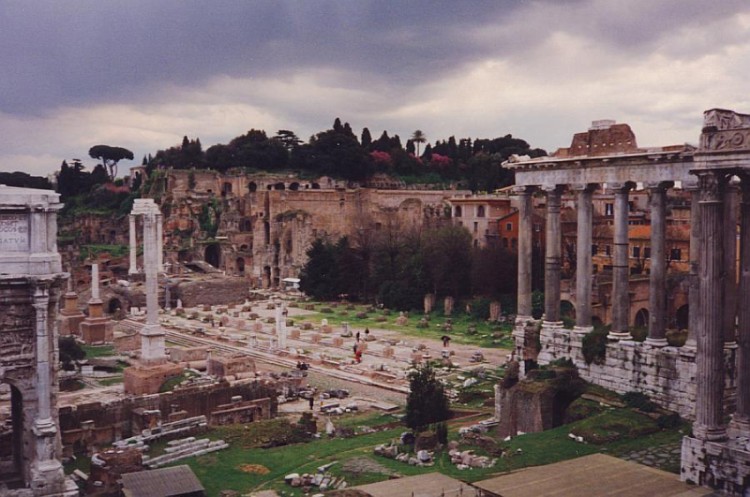|
|
 |
|
The Forum Romanum |
|
written
by eatonj / 09.01.2004 |
|
|
| |
Introduction |
| |
| |

|
| http://www.wikinfo.org/upload/f/fb/Forum_Romanum.jpg |
| The Roman Forum Today |
| Here is a view from the steps decending down behind the Arch of Septimius Severus looking out over the Forum as it appears today. |
| |
|
| |

|
| Claridge, Amanda. Rome. pg 64. (see bibliography) |
| The Late Imperial Forum |
| Here is an artists interpretation of how the Forum might have looked during the late empire (We know that it is at least after 285 because the honorary columns are in place). The size of the people in the Forum can give us some idea of just how huge these buildings once were. |
| |
|
The history of the Great Roman Forum dates as far back as the history of Rome itself. The area where the Forum lies today was once a marshy valley set between the Palatine and Capitoline where tribes settled on the surrounding hills would come to collect water and to bring their cattle to graze as early as the 9th century BC. Archaeological evidence shows that land around the edges of the Forum area was used as burial grounds around 700 BC, and remnants of about a dozen huts have been found from around 670 BC according to modern dating techniques. According to ancient Roman myth, the Forum was the site where Rome’s founding brothers Romulus and Remus would have met between their two strongholds on the Palatine and Capitoline hills when Rome was founded in 753 BC. This was also the place where the alleged peace agreement between Romulus and Tatius was made, official making the Sabine people a part of Rome.
On account of severe flooding around 620 BC, the Romans began systematic drainage of the Forum area and a constructed the Cloaca Maxima, an underground drain that still functions today. No longer a bog, and without the constant threats of floods, the central location of the Forum amongst the seven hills of Rome lent itself perfectly as a location for local merchants to bring and sell their food and goods and by 550 BC the Forum served exclusively as a marketplace. When Rome transitioned into a Republic in 509 BC, the Forum, as the main market already a place of public assembly and home to the sacred temples to Saturn and Vesta, was of course the natural place for the business of the state to be carried out. From this point growth in the Forum occurred in a somewhat indiscriminate way over the next four hundred plus years of Republic with consuls constructing new monuments to elicit both personal popularity and public pride.
This all changed when Julius Caesar seized the role of solitary consul for life in 48 BC. Caesar, desiring to solidify his power and impress his people, gave the Forum a brand new, much more majestic look, most notably by moving the Rostra to create a strong axis down the center, constructing a brilliant new Curia for the powerless Senate, and building an immense new Basilica Julia as a symbol of Roman judicial power. These transformations were continued by his adopted son and heir Augustus and by the end of Augustus’ reign, the layout of the Forum as we see it today was mostly established.
After this each emperor added his personal touch to the Forum, trying to construct statuaries and temples and other public works in and around the Forum by which he might be remembered. Fire ravaged the Forum in 283 AD, destroying everything made of wood, marble, or any other exotic material that would burn. However, the Forum was quickly rebuilt as a nearly exact replica of what it had been by the emperor Diocletian.
After the sack and eventual fall of the Roman Empire in the West, the pagan monuments of the Forum were largely forgotten by the new Catholic order that oversaw Rome. Certainly lack of general upkeep and a great earthquake in 867 caused dilapidation of the Forum, but the greatest destruction came at the hands of 15th-18th century stone-robbers in search of materials out of which to build new churches. Every piece of usable marble was taken and used directly in one of Rome’s great houses of worship, and that which was not usable was taken to be melted for lime.
Excavations on the Forum began in the early 19th century at the Arch of Septimius Severus and Column of Phocas, but did not get seriously underway until 1870 when the Basilica Julia and central area of the Forum was laid bare. Excavations have proceeded intermittently since then. Large projects of restoration and preservation were undertaken in the 1980s. Today the Forum serves as a site worthy of a visit by everyone from historians and archaeologists to tourists from all corners of the world and college art history classes.
|
| |
|
| |
|
|
 |
|
